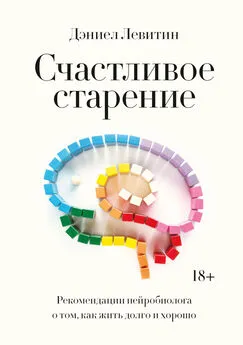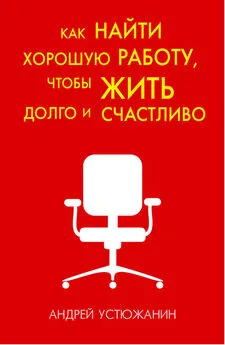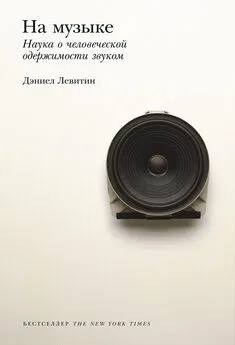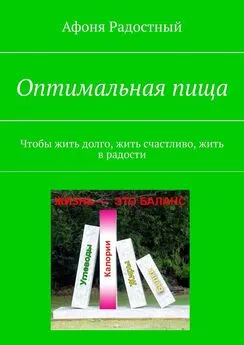Дэниел Левитин - Счастливое старение. Рекомендации нейробиолога о том, как жить долго и хорошо
- Название:Счастливое старение. Рекомендации нейробиолога о том, как жить долго и хорошо
- Автор:
- Жанр:
- Издательство:Манн, Иванов и Фербер
- Год:2021
- Город:Москва
- ISBN:9785001695868
- Рейтинг:
- Избранное:Добавить в избранное
-
Отзывы:
-
Ваша оценка:
Дэниел Левитин - Счастливое старение. Рекомендации нейробиолога о том, как жить долго и хорошо краткое содержание
Ответы на эти и многие другие вопросы вы найдете в книге известного нейробиолога и автора бестселлеров о природе возрастных изменений и о том, как можно прожить долго и что нужно делать сейчас (в любом возрасте), чтобы в 70, 80 и 90 жить полной жизнью.
Книга предназначена для широкого круга читателей.
На русском языке публикуется впервые.
Счастливое старение. Рекомендации нейробиолога о том, как жить долго и хорошо - читать онлайн бесплатно ознакомительный отрывок
Интервал:
Закладка:
407
T. Hedden and J. D. Gabrieli, “Insights into the Ageing Mind: A View from Cognitive Neuroscience,” Nature Reviews Neuroscience 5, no. 2 (2004): 87.
408
Löckenhoff and Carstensen, “Socioemotional Selectivity Theory.”
409
L. A. Leotti, S. S. Iyengar, and K. N. Ochsner, “Born to Choose: The Origins and Value of the Need for Control,” Trends in Cognitive Sciences 14, no. 10 (2010): 457–463.
410
E. J. Langer and J. Rodin, “The Effects of Choice and Enhanced Personal Responsibility for the Aged: A Field Experiment in an Institutional Setting,” Journal of Personality and Social Psychology 34, no. 2 (1976): 191.
411
A. Bandura and R. Wood, “Effect of Perceived Controllability and Performance Standards on SelfRegulation of Complex Decision Making,” Journal of Personality and Social Psychology 56, no. 5 (1989): 805.
412
E. M. Tricomi, M. R. Delgado, and J. A. Fiez, “Modulation of Caudate Activity by Action Contingency,” Neuron 41, no. 2 (2004): 281–292; G. Coricelli et al., “Regret and Its Avoidance: A Neuroimaging Study of Choice Behavior,” Nature Neuroscience 8, no. 9 (2005): 1255.
413
Leotti, Iyengar, and Ochsner, “Born to Choose.”
414
R. M. Ryan et al., “The Significance of Autonomy and Autonomy Support in Psychological Development and Psychopathology,” in Developmental Psychopathology, vol. 1, Theory and Method, ed. D. Cicchetti and D. J. Cohen, pp. 795–849 (Hoboken, NJ: John Wiley and Sons, 2015).
415
C. Kilgannon, “The World’s Oldest Barber Is 107 and Still Cutting Hair Full Time,” The New York Times, October 7, 2018, https://www.nytimes.com/2018/10/07/nyregion/worlds-oldest-barber-anthony-mancinelli.html.
416
Y. Hayashi and R. Tracy, “Partisan or Deal Maker? Maxine Waters Rises as Banking Industry’s Overseer,” The Wall Street Journal, November 20, 2018, https://www.wsj.com/articles/partisan-or-deal-maker-maxine-waters-rises-as-banking-industrys-overseer-1542717000.
417
A. P. Shimamura, Get SMART! Five Steps toward a Healthy Brain (Scotts Valley, CA: CreateSpace, 2017).
418
Shimamura, Get SMART!.
419
Shimamura, Get SMART!.
420
N. D. Anderson et al., “The Benefits Associated with Volunteering among Seniors: A Critical Review and Recommendations for Future Research,” Psychological Bulletin 140, no. 6 (2014): 1505.
421
Anderson et al., “The Benefits Associated with Volunteering.”
422
International Labour Organization, Manual on the Measurement of Volunteer Work (Geneva, Switzerland: International Labour Organization, 2011).
423
M. C. Carlson et al., “Exploring the Effects of an ‘Everyday’ Activity Program on Executive Function and Memory in Older Adults: Experience Corps,” Gerontologist 48 (2008): 793–801.
424
T. D. Windsor, K. J. Anstey, and B. Rodgers, “Volunteering and Psychological Well-Being among Young-Old Adults: How Much Is Too Much?” Gerontologist 48, no. 1 (2008): 59–70.
425
Подзаголовок этой главы взят из старого анекдота. Человек приходит к врачу и, резко толкая себя локтем в бок, говорит: «Мне больно, когда я это делаю». Врач отвечает: «Так не делайте этого!»
426
R. J. Gatchel et al., “The Biopsychosocial Approach to Chronic Pain: Scientific Advances and Future Directions,” Psychological Bulletin 133, no. 4 (2007): 581.
427
C. S. Lin, S. Y. Wu, and C. A. Yi, “Association between Anxiety and Pain in Dental Treatment: A Systematic Review and Meta-analysis,” Journal of Dental Research 96, no. 2 (2017): 153–162; M. Zhuo, “Neural Mechanisms Underlying Anxiety – Chronic Pain Interactions,” Trends in Neurosciences 39, no. 3 (2016): 136–145.
428
N. D. Volkow and A. T. McLellan, “Opioid Abuse in Chronic Pain – Misconceptions and Mitigation Strategies,” New England Journal of Medicine 374, no. 13 (2016): 1253–1263.
429
World Health Organization, “About the Global Burden of Disease (GBD) Project,” https://www.who.int/healthinfo/global_burden_disease/about/en/; http://www.healthdata.org/data-visualization/gbd-compare; R. Lozano et al., “Global and Regional Mortality from 235 Causes of Death for 20 Age Groups in 1990 and 2010: A Systematic Analysis for the Global Burden of Disease Study 2010,” Lancet 380, no. 9859 (2012): 2095–2128.
430
http://www.healthdata.org/data-visualization/gbd-compare.
431
D. J. Gaskin and P. Richard, “The Economic Costs of Pain in the United States,” Journal of Pain 13, no. 8 (2012): 715–724.
432
N. D. Volkow and A. T. McLellan, “Opioid Abuse in Chronic Pain – Misconceptions and Mitigation Strategies,” New England Journal of Medicine 374, no. 13 (2016): 1253–1263.
433
H. K. Beecher, “Pain in Men Wounded in Battle,” Annals of Surgery 123, no. 1 (1946): 96.
434
Наблюдение о том, что можно провести различие между сенсорной и аффективной составляющей боли, стало основой статьи Мелзака и Уолла (1965 год), положившей начало современным исследованиям этой проблемы: R. Melzack and P. D. Wall, “Pain Mechanisms: A New Theory,” Science 150 (1965): 971–979; см. также: J. Katz and B. N. Rosenbloom, “The Golden Anniversary of Melzack and Wall’s Gate Control Theory of Pain: Celebrating 50 Years of Pain Research and Management,” Pain Research and Management 20, no. 6 (2015): 285–286.
435
H. K. Beecher, “Relationship of Significance of Wound to Pain Experienced,” Journal of the American Medical Association 161, no. 17 (1956): 1609–1613.
436
Melzack and Wall, “Pain Mechanisms.”
437
R. Melzack, “The McGill Pain Questionnaire from Description to Measurement,” Anesthesiology 103, no. 1 (2005): 199–202.
438
R. D. Treede et al., “The Cortical Representation of Pain,” Pain 79, nos. 2–3 (1999): 105–111.
439
В коре головного мозга существует «карта» для отображения моторных движений, которую также составил Пенфилд, с линейной схемой того, как в мозге представлены мышцы – от головы до пальца ноги. На мышцы лица и глотки приходится около 40 процентов двигательной коры головного мозга, а кистям рук соответствует еще 30 процентов. Следовательно, на управление всеми остальными частями тела приходится всего 30 процентов двигательной коры. Эти 70 процентов дают нам возможность разговаривать, жестикулировать во время беседы, а также играть на музыкальных инструментах; а еще 30 процентов, которые управляют кистями рук, – это и есть то, что позволяет часовщикам, художникам и другим высококвалифицированным специалистам делать свое дело. Как показывают исследования, благодаря обучению и накоплению опыта соответствующие области мозга увеличиваются в размере.
440
M. C. Bushnell, M. Čeko, and L. A. Low, “Cognitive and Emotional Control of Pain and Its Disruption in Chronic Pain,” Nature Reviews Neuroscience 14, no. 7 (2013): 502.
441
I. A. Strigo et al., “Psychophysical Analysis of Visceral and Cutaneous Pain in Human Subjects,” Pain 97, no. 3 (2002): 235–246. Участников исследования подвергали тепловому воздействию, которое вызывало боль на поверхности грудной клетки, или в их пищевод вводили и надували воздушный шар. Воздушный шар в пищеводе вызывает дискомфорт, подобный ощущению от эндоректального зонда, который иногда используют в эндоскопии. На кожу испытуемых воздействовали температурой 46 градусов по Цельсию, а висцеральное давление составляло 40 миллиметров ртутного столба.
442
Strigo et al., “Psychophysical Analysis.”
443
F. Cervero and L. A. Connell, “Distribution of Somatic and Visceral Primary Afferent Fibres within the Thoracic Spinal Cord of the Cat,” Journal of Comparative Neurology 230, no. 1 (1984): 88–98; F. Cervero and L. A. Connell, “Fine Afferent Fibers from Viscera Do Not Terminate in the Substantia Gelatinosa of the Thoracic Spinal Cord,” Brain Research 294, no. 2 (1984): 370–374.
444
I. A. Strigo et al., “Differentiation of Visceral and Cutaneous Pain in the Human Brain,” Journal of Neurophysiology 89 (2003): 3294–3303.
445
I. A. Strigo et al., “The Effects of Racemic Ketamine on Painful Stimulation of Skin and Viscera in Human Subjects,” Pain 113, no. 3 (2005): 255–264.
446
P. Raineville, “Brain Mechanisms of Pain Affect and Pain Modulation,” Current Opinion in Neurobiology 12 (2002): 195–204.
447
L. Sztriha et al., “Congenital Insensitivity to Pain with Anhidrosis,” Pediatric Neurology 25, no. 1 (2001): 63–66.
448
S. Mardy et al., “Congenital Insensitivity to Pain with Anhidrosis (CIPA): Effect of TRKA (NTRK1) Missense Mutations on Autophosphorylation of the Receptor Tyrosine Kinase for Nerve Growth Factor,” Human Molecular Genetics 10, no. 3 (2001): 179–188.
449
NIH, US National Library of Medicine, Genetics Home Reference, “SCN9A Gene,” https://ghr.nlm.nih.gov/gene/SCN9A#location.
450
E. M. Nagasako, A. L. Oaklander, and R. H. Dworkin, “Congenital Insensitivity to Pain: An Update,” Pain 101, no. 3 (2003): 213–219.
451
P. D. Wall, Pain: The Science of Suffering (New York: Columbia University Press, 2000).
452
Интервал:
Закладка:








![Дэниел Левитин - Путеводитель по лжи [Критическое мышление в эпоху постправды]](/books/1101191/deniel-levitin-putevoditel-po-lzhi-kriticheskoe-my.webp)

